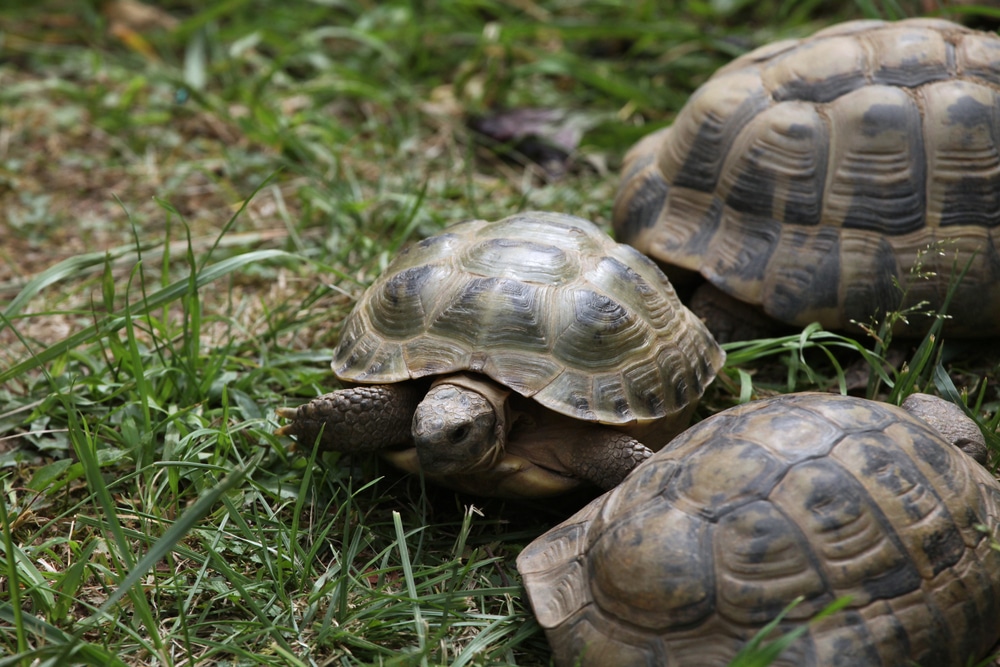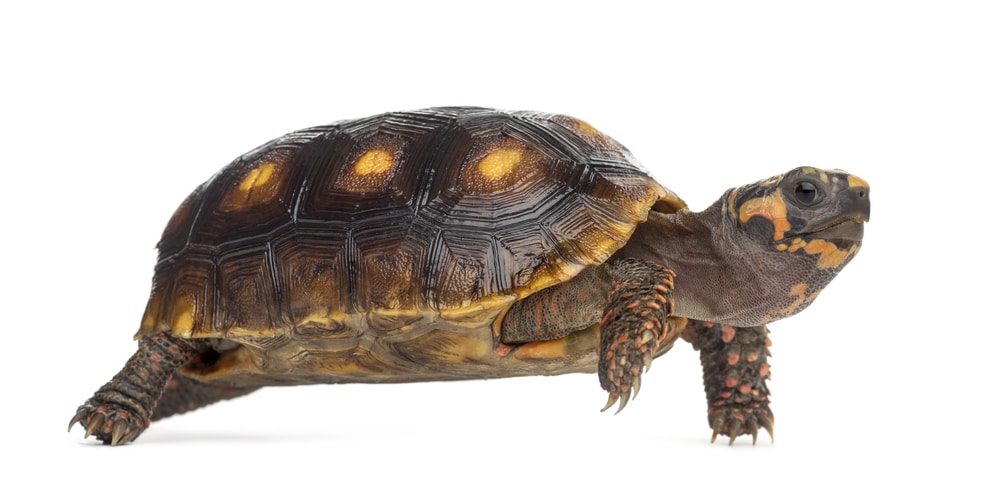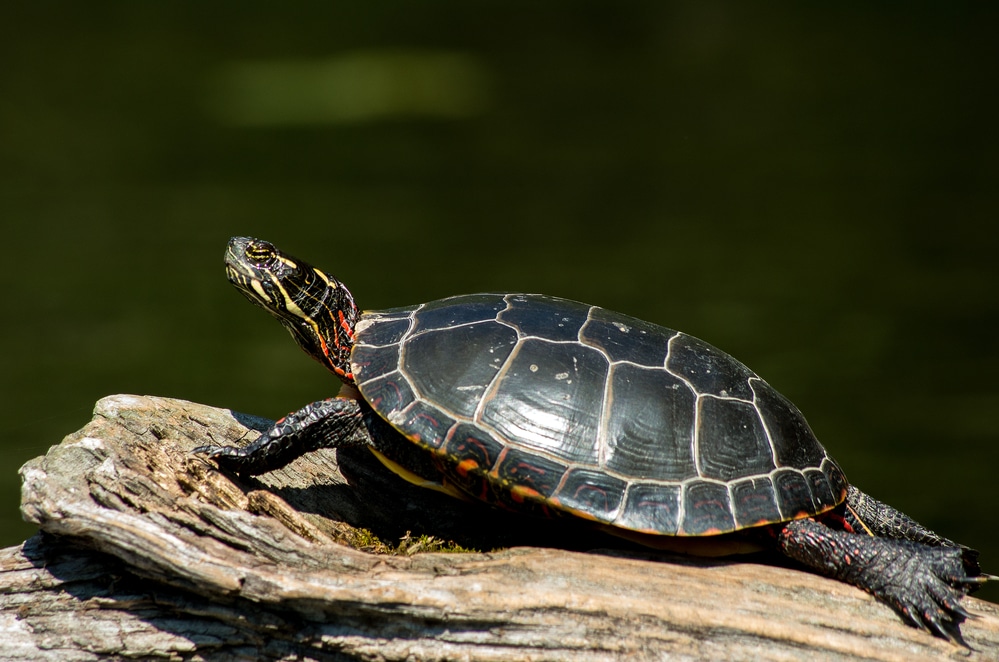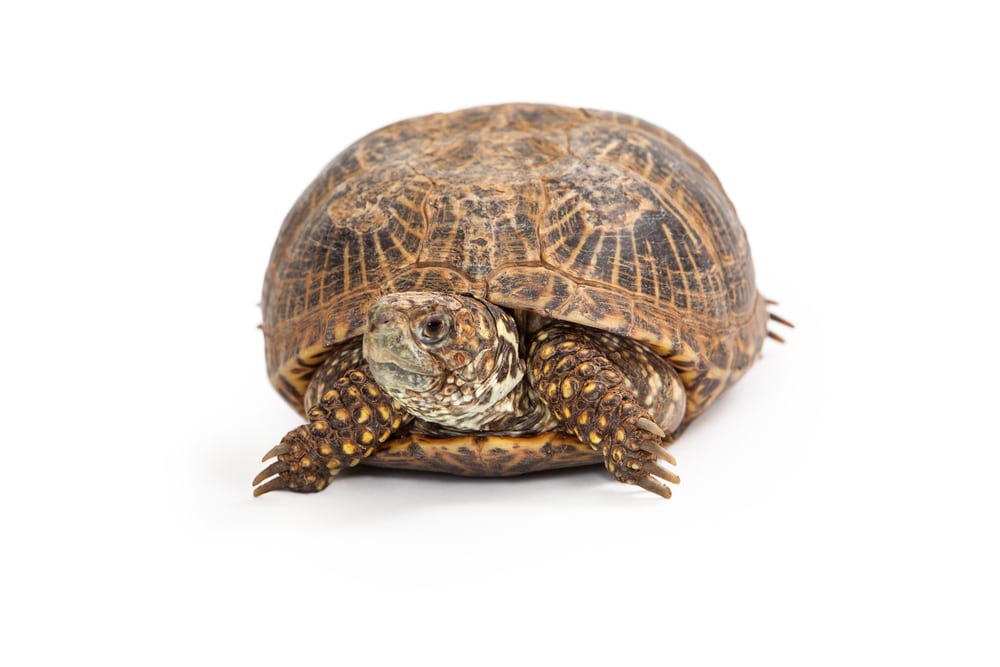If you are interested in adding a pet reptile to your family, but you don’t want a snake, lizard or crocodilian, you may want to consider picking up a pet turtle.
There are a variety of turtles that make rewarding pets, including several species that are easy enough to maintain for beginners.

We’ll detail 12 of the best pet turtle species below (including terrestrial, aquatic and semi-aquatic versions) and explain some of their basic requirements.
Just be sure to consider your choice carefully, as many turtles have incredibly long lifespans – you don’t want to purchase a turtle you don’t end up enjoying and then have to care for him for the next several decades!
Quick Navigation
A Quick Note about Terminology
The terms “turtle,” “tortoise,” and “terrapin” are all used when talking about chelonians (the scientific name for any member of the Order Testudines), and they lead to a lot of confusion.
We’ll try to cut through the confusion by explaining each term below:
- The term “tortoise” is usually applied to animals that live exclusively on the land, but it is best applied to members of the Family Testudinidae.
- The term “terrapin” is usually used to describe aquatic species, especially if they’re collected as food for humans.
- The term “turtle” is usually used to describe aquatic or semi-aquatic species, but it can also be used broadly, to describe any type of chelonian.
Moving forward, we’ll generally use the term “tortoise” to refer to land-dwelling members of the Family Testudinidae, and we’ll use “turtle” as a catch-all term, which could refer to any chelonian.
Think Before Your Buy: Important Turtle Selection Considerations
As mentioned before, turtles represent a long-term commitment, so you must consider your choice of species carefully.
To help ensure you pick a good species, we’ve detailed some of the most important factors you’ll want to think about when making your choice.
Terrestrial, Aquatic or Semi-Aquatic
There are 350-odd turtle species in the world, and they all exhibit one of three basic lifestyles: Some live almost entirely on dry ground, others live almost exclusively in the water, and some split their time between the two.
You can select any of the three lifestyles you like, but it is important to understand that each presents a distinct set of challenges.
Typically, terrestrial species are the easiest to house and maintain, as you needn’t worry about installing filtration systems or worrying about water quality.
On the other hand, maintaining aquatic or semi-aquatic species will require you to establish a water-filled (or partially water-filled) habitat, as well as the necessary filtration equipment.
Note that you’ll typically need a high-end (read: expensive) filter to keep the water in a turtle tank clean, as they typically produce much higher quantities of waste than fish of similar size.
Avoid Very Large Species
A few popular turtles and tortoises reach sizes that make them difficult for the average reptile enthusiast to house.
African spur-thighed tortoises (Centrochelys sulcata), for example, can reach weights in excess of 200 pounds. Turtles of this size not only require immense habitats, which few keepers have the resources to provide, they’re also challenging to handle and feed.
Some large species can also represent a safety hazard to their keepers.
Snapping turtles (Chelydra serpentina), alligator snapping turtles (Macrochelys temminckii), and a variety of soft-shelled turtles (Apalone spp.) all have relatively foul temperaments and grow large enough that their bites can be serious and require medical attention.
Think About Your New Turtle’s Temperament
Different keepers like to interact with their pets in different ways. Some view turtles much like aquarists view their fish – they’re to be enjoyed visually, but they rarely put their hands on their pet.
Other turtle enthusiasts like to directly interact with their pets, including lots of petting and touching.
Either approach is acceptable, but you’ll want to figure out which type of owner you intend to be when picking a species.
If you want to handle your pet, you’ll need to select a species that is typically accepting of human interaction.
Conversely, you can select a species with a defensive temperament if you don’t wish to touch him very often and are willing to learn how to handle your new pet safely (when necessary).
Figure Out the Foods You Want to Provide Your Pet
Different turtle species require different types of diets, and you’ll want to think carefully about this before picking a species.
Some are largely carnivorous and will require animal-based foods, including things like minnows, crickets, worms and rodents. Other species are primarily herbivorous, and they require a variety of fruits and vegetables to remain healthy. In practice, most popular pet species are omnivores, who’ll require a combination of plant- and animal-based foods to thrive.
Generally speaking, plant-based foods are easier to prepare and cheaper to purchase, but they also present challenges with respect to balancing the vitamins and minerals present in your pet’s diet.
Be Realistic About Your Budget
While a few turtle species have very high price tags, which may reach into five-digit territory, there are a number of turtle species that are available to hobbyists for less than $100 or so (and some are much cheaper than this). However, it is important to remember that you don’t just have to buy a turtle – you must also purchase your new pet’s habitat, lighting fixtures and his other needs. You’ll also have to pay for his food, habitat upkeep and veterinary care over time.
So, be sure to keep your budget in mind when picking out your pet. You don’t want to spend your entire budget on a turtle, only to find that you are unable to afford the type of habitat he requires.
Try to Select a Captive-Bred Animal
As is the case with almost every reptile species in the world, captive-bred individuals are preferable to their wild-caught counterparts. The reasons captive-bred individuals are preferable are legion, but a few of the most notable include:
- Captive-bred reptiles are rarely heavily parasitized, while wild-caught individuals almost always are.
- Wild-caught animals typically become very stressed during the capture and shipping processes.
- Purchasing a captive-bred reptile does not deplete wild populations.
Unfortunately, some species are rarely bred in captivity, so you don’t always have the option of selecting a captive-bred individual. However, you should always try to do so if at all possible.
Terrestrial Pet Turtles
If you think a terrestrial turtle is the best choice for you, check out one of the following three species. Each one is relatively easy to care for and should thrive in your care.
Russian Tortoises

Russian tortoises (Agrionemys horsfieldii) are one of the very best tortoise species for fledgling keepers to consider.
In fact, Russian tortoises are nearly ideal for beginners. They’re a relatively small species, who normally reach about 4 to 5 inches in straight-line shell length, and they have delightful personalities, which may be described as somewhat “outgoing.” R
ussian tortoises are also typically hardy animals, who can remain healthy despite their keeper’s mistakes.
It is important to note that most Russian tortoises offered for sale are wild-caught animals. This means you’ll need to work with your vet closely to eliminate any parasites your pet may be harboring and ensure he isn’t suffering from any other health problems.
Greek Tortoises

Greek tortoises (Testudo graeca) are quite similar to Russian tortoise in many ways, so it shouldn’t be surprising that they also make good pets.
Greek tortoises grow a bit larger than their Russian counterparts, as they average about 5 to 8 inches in length. Additionally, a few geographical subspecies are capable of reaching even larger sizes, potentially exceeding 10 inches. Accordingly, you’ll want to be sure you have enough space to provide your new pet before picking up a Greek tortoise of your own.
Greek tortoises are largely herbivorous, and they thrive best when provided with warm and dry conditions. However, like all tortoises, they should still be provided with water (although some keepers only offer water periodically), and they should have at least one hide spot with a relatively high humidity level.
Red-Footed Tortoises

Red-footed tortoises (Chelonoidis carbonarius) are another one of the most popular tortoise species on the reptile market. Given their endearing personalities and attractive color patterns, it is easy to see why this is the case.
These turtles aren’t quite as easy to care for as Russian or Greek tortoises, as they reach much larger sizes – some eventually exceed 18 inches in length, although most are around 1-foot long. They require large, humid enclosures and plenty of fresh fruits and vegetables to remain healthy.
Native to the periphery of the Amazon Basin, these turtles are most commonly encountered in transition zones, where grasslands and forests meet. Red-footed tortoises get their name from the red spots on their legs, but this is sometimes a misnomer, as they can also feature yellow or orange markings instead.
Aquatic Turtles
If you’d like to set up a large, water-holding enclosure for your pets, you may want to consider selecting an aquatic species. Note that all three of the species discussed below will spend the majority of their time in the water, but they all require some land area in their habitat, which will give them the ability to climb out of the water and bask.
Painted Turtles

Painted turtles (Chrysemys picta) make great pets for beginning reptile keepers who are interested in aquatic turtles. Among other things these turtles have going for them, they remain reasonably sized (most are less than 10 inches long), they typically have pretty relaxed temperaments, and they are easy to care for.
Painted turtles are found across most of North America, with different geographic regions harboring different subspecies. Nevertheless, they are all largely similar from a husbandry point of view, and the primary way they differ is in terms of shell markings.

Painted turtles require more vegetable matter in their diet than many other aquatic turtles (especially once they’re mature), but you’ll also want to provide them with some animal-based foods (especially while they’re young).
Red-Eared Sliders

Red-eared sliders (Trachemys scripta) are likely the most commonly kept turtle species in the world. There are a variety of reasons that this is the case, but chief among them is certainly the species’ hardy nature, which makes them a breeze to maintain.
Red-eared sliders are medium-sized turtles; males reach about 6 inches or so in length, but females grow much larger and occasionally exceed 12-inches in shell length. Accordingly, you’ll need to be sure you have enough space to house these turtles before adding one to your home.
Another reason these turtles are so popular is their affordable price tag – these turtles can often be purchased for $20 or less. However, you still need to consider the additional costs you’ll incur while caring for these turtles, as large aquaria are not cheap (nor are filtration systems for large aquaria).
Note that because many hobbyists have released unwanted red-eared sliders into local ponds and lakes, this species has expanded its range greatly, which has caused environmental harm in some places. Accordingly, these turtles are prohibited pets in some areas, so you’ll need to check your local laws before purchasing one.
Musk Turtles

Musk turtles (Sternotherus odoratus) are a very underappreciated species that more keepers should consider. Admittedly, they aren’t as classically attractive or colorful as some other species, but they are still fascinating animals, which can be very fun to watch explore their enclosure.
Musk turtles are also relatively easy to maintain. For starters, they’re relatively small turtles, who typically reach about 4 to 5 inches in length, and they’re very opportunistic feeders, who can subsist on a variety of foods. Also, while they are aquatic turtles, they don’t require very deep water, as they prefer to walk along the bottom rather than swim.

Musk turtles can occasionally be antagonistic to other turtles housed with them, so care is warranted when introducing them to multispecies enclosures. They can also have rather prickly temperaments, but many calm down a bit over time.
Semi-Aquatic Turtles
Semi-aquatic turtles require their keeper to provide both land and water sections in the habitat, which may make them slightly harder to accommodate that some of the previously discussed species. Nevertheless, they can still make very rewarding captives, and the three species below are often easy for new keepers to maintain.
Spotted Turtles

One of the most endearing turtles in the world, spotted turtles (Clemmys guttata) are a fantastic semi-aquatic species for reptile enthusiasts to maintain. Not only are these yellow-spotted chelonians quite pretty, but they also have interesting personalities, which make them fun to care for.
Spotted turtles reach about 4 to 5 inches in length, so they don’t require very large enclosures. Additionally, while they do require a water section in their habitat, they don’t need access to very deep water – 4 to 6 inches of depth will suffice. You’ll need to provide your spotted turtle with a varied diet, but they primarily feed on animal-based foods.
Note that spotted turtles are protected in some areas, as their wild populations have been in decline for many years. Accordingly, it is important to check your local laws and regulations before purchasing one, and always opt for a captive-bred individual to avoid placing additional stress on wild populations.
Box Turtles

Box turtles (Terrapene spp.) are among the most familiar turtles to North American keepers, as they’re frequently encountered in parks and backyards, and they’re even seen crossing roads from time to time. And, as it turns out, these turtles can make great pets in many cases.
Box turtles are relatively small turtles, who rarely exceed 5 or 6 inches in length, which means they’re generally easy to house. They do, however, require terrestrial and aquatic areas in their enclosure, so you’ll still need to provide them with a relatively large habitat. They needn’t have access to deep water – an inch or two will suffice for their hydration and behavioral needs for water.
Box turtles are usually very easy to feed, as they’ll accept a wide variety of plant- and animal-based foods. They are a shy species, who’ll typically respond to their keeper by withdrawing into their shell and “closing” it via a hinge on their plastrons.
Wood Turtles
Wood turtles (Glyptemys insculpta) are a bit of an under-the-radar species, but like the musk turtles discussed earlier, they deserve more consideration from turtle enthusiasts. Wood turtles are typically quite tame and good-natured, and many keepers suspect that they’re smarter than the average turtle too. These turtles are even capable of climbing (which is important to remember when designing their habitats)!
Note that while wood turtles are somewhat small (most specimens reach 5 to 8 inches in shell length), they still require relatively spacious enclosures, as these turtles travel long distances in the wild. They are omnivores, but they’ll primarily subsist on vegetable matter as adults (young wood turtles consume more animal prey to fuel their growth).
Like spotted turtles, wood turtles are under significant pressure in the wild, so it is imperative that you select captive-bred individuals and verify that they are legal to keep in your area before making a purchase.
Conclusion
Turtles can certainly make great pets, but – as with any other type of reptile – you must be sure to select a species that you can care for properly. It’s also important to remember that most turtles will live very long lives, so you must also pick one you’re sure you’ll still enjoy caring for decades from now. You should never release a captive reptile into the wild, so you’ll likely be “stuck” with your turtles for the foreseeable future.
But, as thousands of turtle enthusiasts around the world already know, chelonians are pretty cool critters and they can be a blast to add to your family.